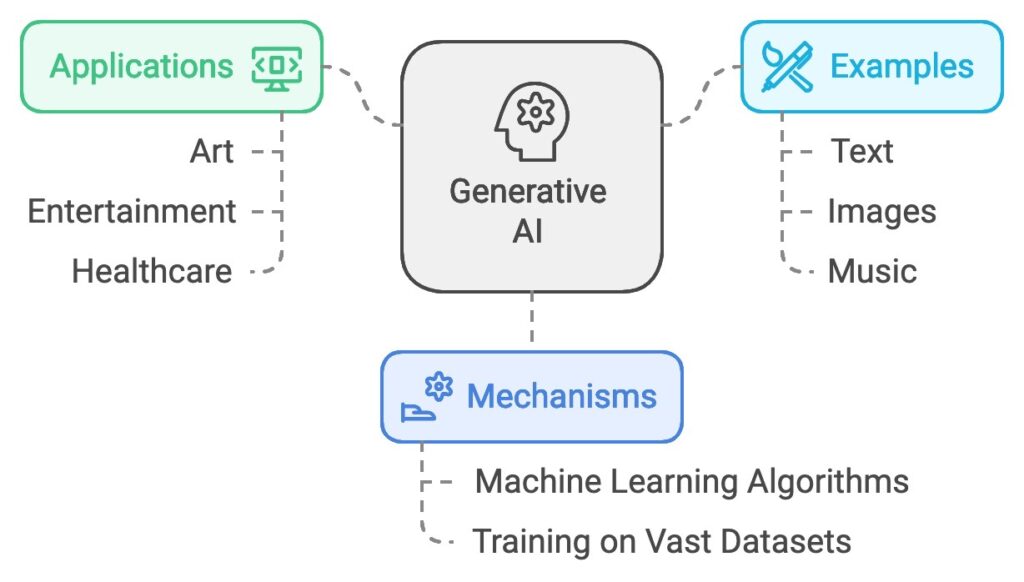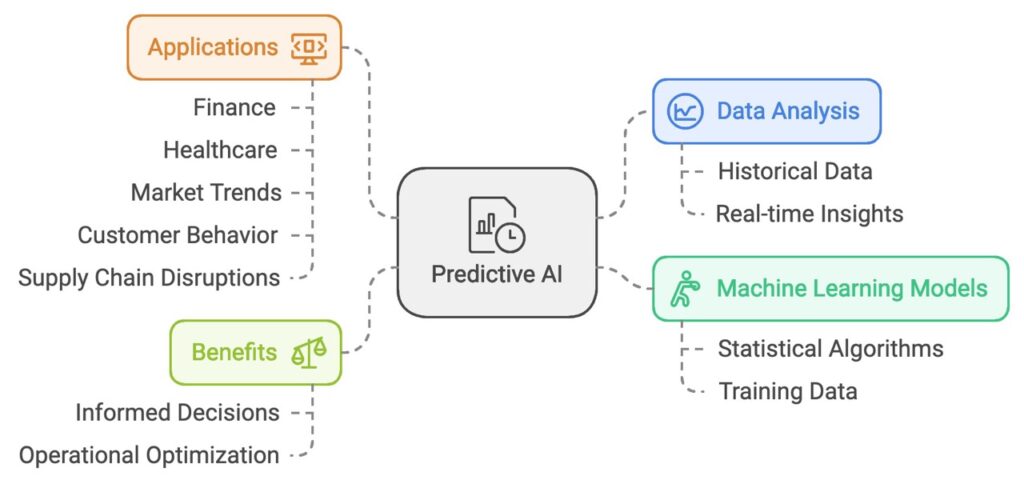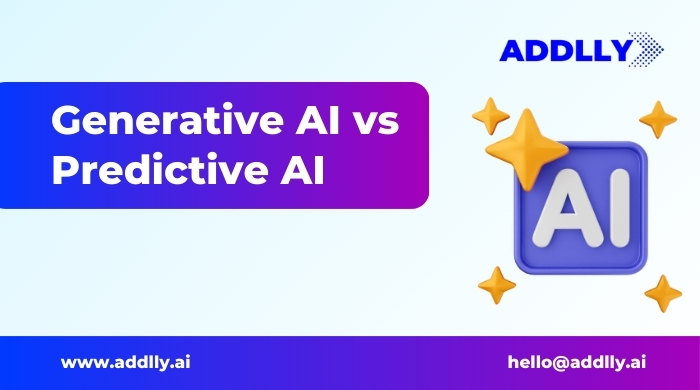Generative AI vs Predictive AI are two of the most prominent advancements in artificial intelligence, each with distinct purposes. Generative AI creates new data or content from training data, while Predictive AI focuses on analyzing historical data to predict future outcomes.
Both generative AI models and predictive AI models are transforming industries by helping businesses innovate and optimize.
This blog will explore how these AI technologies differ, their applications, and their respective strengths in fields like content creation, fraud detection, and future trends forecasting.
Quick Summary Powered by Addlly AI
ToggleWhat is Generative AI?

Generative AI is a branch of artificial intelligence that creates new content, such as text, images, or even music, based on the data it has been trained on. Using machine learning algorithms, generative AI tools like Addlly AI learn from vast datasets and generate novel outputs that mimic the style or nature of the original data.
This ability to generate synthetic data has proven useful in areas like art, entertainment, and healthcare. Unlike predictive AI, which relies on historical data to forecast future outcomes, generative AI models focus on creativity and producing entirely new outputs.
Check out our guide about Generative AI for Enterprises to learn how AI can enhance your marketing and content creation.

How Generative AI Works: Techniques and Models
Generative AI works through several advanced models that create data based on learned patterns. These models use neural networks and machine learning algorithms to process input data and generate realistic outputs.
1. GANs (Generative Adversarial Networks)
Generative Adversarial Networks (GANs) are a type of generative AI model that uses two neural networks: the generator and the discriminator. The generator creates new data (such as realistic images), while the discriminator evaluates whether the data is real or generated.
This back-and-forth process improves the quality of the output, allowing GANs to generate highly realistic images and content based on training data. GANs are widely used in content creation and image synthesis.
2. Variational Autoencoders (VAEs)
Variational Autoencoders (VAEs) are a type of generative AI model that compresses input data into a simpler form and then reconstructs it to create new, realistic outputs. VAEs learn data patterns and generate similar outputs by adjusting the encoded information.
They are widely used in tasks like synthetic data generation and image recreation. VAEs are valuable for generating data that follows the same patterns as the original dataset.
3. Diffusion Models
Diffusion models are another technique in generative AI that involve adding noise to input data, such as images, and then learning to reverse this process to generate new, clean data. These models are commonly used in generating high-quality images, such as those found in modern AI image tools.
By training on large datasets, diffusion models improve the ability to create realistic and complex images or content from noise.
Also read our article about AI Agentic Workflow in Marketing.
Common Use Cases of Generative AI

1. Content creation (text, images, music, and videos)
Generative AI excels in content creation by using machine learning algorithms to generate text, images, music, and videos based on training data. Popular tools like deep neural networks and GANs enable AI to create realistic images or compose original music.
These generative AI applications speed up content production for businesses in media, marketing, and entertainment, allowing for faster, cost-effective creative outputs. There are many tools available like AI Writer, AI Blog Writer, AI Social Media Post Generator, etc., using which you can create content.
2. Code generation
Generative AI models can generate programming code automatically by analyzing vast datasets of existing code. This application is beneficial for software development, where AI models assist developers by generating boilerplate code, suggesting solutions, or automating repetitive coding tasks.
These tools enhance developer productivity and allow businesses to streamline their software development processes, reducing both time and costs.
3. Virtual environments in gaming
In gaming, generative AI is used to create realistic virtual environments, characters, and animations. By analyzing historical data from past games and visual patterns, AI tools generate detailed game settings, allowing game developers to automate part of the design process.
This reduces manual effort while ensuring immersive and lifelike virtual worlds. Generative AI in gaming also enhances user experience by enabling more dynamic and adaptive environments.
4. Synthetic data in healthcare
Generative AI creates synthetic data in healthcare, a critical tool for medical research and AI model training. By generating artificial medical records or images, AI helps preserve patient privacy while still providing valuable data for developing diagnostic models.
This method is particularly useful for generating large datasets required for training without compromising sensitive information, supporting innovation in disease detection and treatment development.
For more use cases, read our article Generative AI in Marketing.
Benefits of Using Generative AI
1. Increased creativity and efficiency
Generative AI significantly boosts creativity and efficiency by automating content creation processes such as generating text, images, or even music. By leveraging generative models like GANs and VAEs, businesses can produce creative outputs in a fraction of the time it would take humans, allowing teams to focus on higher-level tasks.
This efficiency drives innovation across industries like marketing, gaming, and media.
2. Automation of repetitive tasks
Generative AI automates repetitive tasks, such as designing graphics, drafting reports, or generating code. By doing so, businesses save time and resources, reducing the need for manual labor. AI tools learn from vast datasets and perform these tasks with high precision, minimizing errors.
Automation not only increases productivity but also enhances operational efficiency across various sectors, including healthcare, media, and e-commerce.
3. Enhancing decision-making
Generative AI helps improve decision-making by providing multiple creative solutions that may not have been considered by humans. By generating new options based on existing data, AI offers alternative perspectives, aiding businesses in problem-solving and strategic planning.
For example, in design or product development, generative models create various prototypes, allowing decision-makers to choose the most effective solution.
Limitations and Challenges of Generative AI
1. Lack of explainability
One major challenge of generative AI is its lack of explainability, especially with complex models like GANs and deep neural networks. These models often act as “black boxes,” making it hard to understand how they generate outputs from training data.
This lack of transparency can be problematic in sectors like healthcare and finance, where decisions based on AI-generated outputs need to be well understood and trusted.
2. Data quality and biases
Generative AI heavily relies on the quality of training data. If the input data is biased, incomplete, or of poor quality, the AI will produce biased or flawed outputs. This issue is particularly concerning in industries like media and healthcare, where biases can lead to harmful consequences.
Ensuring diverse and high-quality datasets is essential for preventing skewed or unethical AI-generated results.
3. Ethical considerations
Generative AI raises significant ethical concerns, such as the potential misuse of AI-generated content. For example, it can be used to create deepfakes or misleading media, raising questions about misinformation and privacy.
Additionally, ethical challenges include copyright issues in content creation and the risk of AI tools being exploited to replace human creativity, impacting job markets.
What is Predictive AI?

Predictive AI, unlike generative AI, analyzes historical data patterns to forecast future outcomes. It uses machine learning models trained on existing data to predict events like market trends, customer behavior, or supply chain disruptions.
Predictive AI’s ability to predict future trends has proven invaluable in industries like finance and healthcare, helping businesses make informed decisions based on statistical algorithms. Predictive models help companies optimize their operations by providing real-time insights based on past and present data.
Read our article about the Best ChatGPT Alternatives.
How Predictive AI Works: Techniques and Algorithms
Predictive AI relies on a variety of techniques and algorithms to analyze and forecast future outcomes. Below is how predictive AI works.
1. Regression Models
Regression model is a key predictive AI model which is used to identify relationships between variables and predict future outcomes. By analyzing historical data, these models provide forecasts for continuous data points like stock prices or sales figures.
Popular types of regression models include linear and logistic regression, which help businesses predict future trends and outcomes based on existing data patterns, enhancing decision-making.
2. Time Series Analysis
Time series analysis is a technique in predictive AI that involves analyzing data points collected over time to predict future outcomes. By examining historical data patterns, such as seasonal trends or cyclical changes, businesses can forecast future events like market trends or sales performance.
This method is widely used in industries such as finance and supply chain management to optimize operations based on data-driven insights.
3. Clustering and Decision Trees
Clustering and decision trees are powerful techniques in predictive AI for grouping data and making decisions. Clustering organizes data into groups with similar characteristics, which helps in identifying trends.
Decision trees, on the other hand, divide data into branches based on decisions or outcomes, helping in classification tasks like fraud detection or customer segmentation. These methods enhance predictive analytics by simplifying complex data structures.
Checkout our guide on: Best AI Playgrounds You Should Try
Common Use Cases of Predictive AI

1. Financial forecasting and fraud detection
Predictive AI plays an important role in financial forecasting by analyzing historical data and market trends to predict future outcomes. In fraud detection, predictive AI monitor transactions and analyze data in real-time to identify unusual patterns or anomalies, helping banks prevent fraudulent activities.
These predictive AI applications are important for improving financial decision-making and risk management, offering increased accuracy and security for financial institutions.
2. Healthcare predictions (patient outcomes and disease outbreaks)
In healthcare, predictive AI models analyze patient data to forecast outcomes, such as recovery chances or potential complications. This helps doctors provide personalized treatment plans. Additionally, predictive AI is used to track disease outbreaks by analyzing population data and identifying trends.
This allows healthcare providers to take proactive measures to prevent widespread outbreaks, improving public health responses.
3. Personalized marketing recommendations
Predictive AI is widely used in personalized marketing to analyze customer behavior and preferences. By leveraging machine learning algorithms, businesses can predict which products or services a customer is likely to purchase next.
This targeted marketing approach improves customer engagement and sales conversions by delivering more relevant recommendations, enhancing user experience and increasing return on investment for businesses.
4. Inventory and supply chain management
Predictive AI helps businesses optimize inventory and supply chain management by forecasting demand based on historical sales data. It enables companies to adjust stock levels, prevent overstocking or shortages, and streamline logistics operations.
By predicting future trends in demand, predictive AI ensures that businesses can meet customer needs efficiently, reducing operational costs and improving overall supply chain performance.
Benefits of Using Predictive AI
1. Improved business efficiency
Predictive AI enhances business efficiency by analyzing historical data to forecast future outcomes, such as sales trends, customer demand, or resource needs. This allows companies to optimize operations, improve inventory management, and allocate resources more effectively.
Predictive models help businesses streamline processes, reduce costs, and improve decision-making, resulting in better performance across various industries, including finance, healthcare, and supply chain management.
2. Enhanced accuracy in forecasts
Predictive AI provides more accurate forecasts by leveraging machine learning algorithms and analyzing vast datasets. This allows businesses to predict market trends, customer behavior, and potential risks with greater precision.
By relying on statistical algorithms, predictive AI reduces uncertainty, enabling organizations to make data-driven decisions and achieve better outcomes in areas like demand forecasting, financial planning, and fraud detection.
3. Greater value from data
Predictive AI helps businesses unlock greater value from their data by identifying patterns, trends, and insights that might otherwise go unnoticed. By analyzing large datasets, predictive AI models enable companies to make more informed decisions and optimize their operations.
This data-driven approach enhances strategic planning and helps businesses stay competitive by anticipating market shifts, customer preferences, and other key factors.
Limitations and Challenges of Predictive AI
1. Dependency on high-quality data
Predictive AI models heavily rely on high-quality data for accurate predictions. If the data used is incomplete, outdated, or biased, the predictions will be flawed. This dependency on data quality makes it challenging for businesses that don’t have access to vast, clean datasets.
Inaccurate or biased data can lead to poor decision-making, affecting business performance and trust in predictive AI systems.
2. Ethical concerns (privacy and bias)
Predictive AI raises ethical concerns, particularly related to privacy and bias. The data used in predictive models often contains sensitive information, making privacy a critical issue. Additionally, biased data can lead to unfair or discriminatory outcomes, especially in areas like hiring or credit scoring.
Addressing these ethical challenges is essential for businesses to use predictive AI responsibly and maintain trust.
3. Computational costs
Training and maintaining predictive AI models can be computationally expensive and resource-intensive. Large datasets require significant processing power and time, which can be costly for businesses.
Additionally, deploying predictive AI at scale requires continuous updates and monitoring to ensure accuracy, further increasing operational costs. These computational demands can limit the practicality of predictive AI for smaller organizations.
Key Differences Between Generative AI and Predictive AI

Creativity vs. Forecasting
Generative AI focuses on creativity by creating new content such as text, images, or videos from existing data. It uses models like GANs to generate entirely new outputs. Predictive AI, on the other hand, analyzes historical data to forecast future outcomes.
Its main purpose is to predict trends or events, making it ideal for business optimization, risk management, and decision-making.
Static vs. Dynamic Outputs
Generative AI typically produces static outputs like images or text, which remain unchanged unless the model generates new content. Predictive AI works in dynamic environments, continually updating predictions as new data becomes available.
This dynamic feedback loop makes predictive AI highly effective in real-time applications like fraud detection, supply chain management, and customer behavior analysis.
Long-term Creation vs. Short-term Decision-Making
Generative AI is more suited for long-term creative tasks, such as product design, content creation, or software development, where innovation is key. In contrast, predictive AI focuses on short-term decision-making by analyzing immediate data trends to forecast future events.
This makes predictive AI ideal for applications that require quick adjustments, such as inventory management or financial forecasting.
Choosing the Right AI for Your Business Needs
Determining whether to use generative AI or predictive AI depends largely on your business objectives. If your goal is to create innovative products, services, or content, generative AI might be the best choice. However, if you’re looking to optimize operations, forecast future market trends, or reduce risks through data-driven decisions, predictive AI would be more appropriate.
Businesses can also combine both AI types to drive innovation while maintaining efficiency, depending on the use case. Understanding the strengths of each AI technology helps ensure that the right model is applied for maximum impact.
The Future of Generative and Predictive AI

Emerging Trends in AI Applications
The future of both generative AI and predictive AI promises innovative trends across multiple industries.
Generative AI will continue revolutionizing content creation with applications in gaming, marketing, and media, including AI-generated art and design. Predictive AI is expected to enhance decision-making with more precise forecasting in fields like healthcare, finance, and supply chain management.
As AI tools evolve, combining both AI types will unlock more advanced capabilities, helping businesses stay competitive and adaptive to future trends.
The Role of Explainability and Ethics in AI
As AI technologies grow, the importance of explainability and ethics will increase. Both generative AI and predictive AI face challenges regarding transparency and bias. Ethical AI will focus on reducing biases in predictive models and ensuring that generative AI is not misused for harmful purposes, like creating deepfakes.
The demand for explainable AI models that clarify how decisions or outputs are generated will continue to rise, especially in sectors like healthcare and finance, where trust is paramount.
Final Words
Generative AI and Predictive AI represent two distinct but equally transformative technologies. While generative AI fosters creativity by producing new content, predictive AI offers valuable insights for forecasting future trends and optimizing operations. Understanding the key differences and applications of these AI models can help businesses unlock new possibilities and achieve their strategic goals.
By leveraging both AI technologies, companies can balance innovation with operational efficiency, ensuring they stay competitive in an increasingly AI-driven world.
FAQs – Generative AI vs Predictive AI
Is ChatGPT Predictive AI or Generative AI?
ChatGPT is a Generative AI model. It generates human-like text by using vast datasets and machine learning algorithms to create conversational responses based on input data. Unlike predictive AI, which forecasts future outcomes, ChatGPT focuses on generating content like text in real-time, enhancing interactions in chatbots and other conversational tools.
Is Alexa a Generative AI?
NO. Alexa primarily uses Predictive AI, not generative AI. It analyzes input data, such as voice commands, and predicts user intent to provide accurate responses. While Alexa may integrate some elements of natural language processing, its core function is based on predicting actions, like setting reminders or providing information, based on user requests.
What is Generative AI vs Predictive AI vs Conversational AI?
Generative AI creates new content, such as text or images, from existing data. Predictive AI forecasts future events by analyzing historical data. Conversational AI, like Alexa or Siri, combines elements of both, enabling interactions through speech by predicting user intent and generating appropriate responses, making it ideal for real-time communication.
Here is what our audience is reading the most:
Best ChatGPT Copywriting Prompts for Winning Copy
Best AI Social Media Post Generators and Tools
Author
-
As an SEO Marketing Specialist at Addlly.ai, my expertise lies in optimizing online visibility through strategic keyword integration and engaging content creation. My approach is holistic, blending advanced SEO techniques with compelling storytelling to enhance brand presence. A true SEO nerd at heart, you'll often find me frequenting the latest SEO blogs, devouring industry insights and soaking up the latest news.
View all posts

